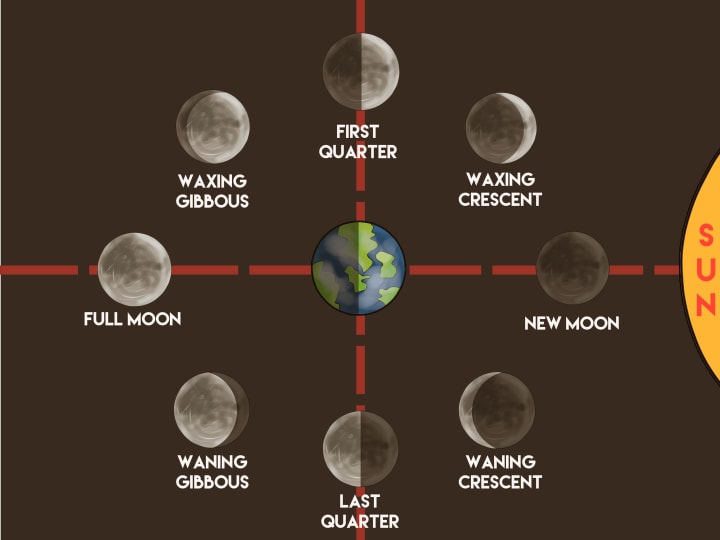The Moon
Our natural satellite and how it affects us all. From pyramids, time-keeping, tidal waves, and the emotional impact on humans and animals, the moon has an effect on us all.

The Aztec's discovered the ancient Mesoamerican city Teotihuacan, or "City of the Gods," in the 1300s. It had already been abandoned by its inhabitants but had early irrigation systems and obsidian deposits which were highly valued at the time. First formed between 150 BCE and 200 CE, the original name of the city has yet to be deciphered. Teotihuacan had its own writing system that used dates and names, almost like the Mayan writing system. The location of the "City of the Gods" in the basin of Central Mexico was utilized and turned into a flourishing hub. It boasted a population of 200,000 at its peak, between 375 CE-500 CE. To this day, no one has discovered exactly why the largest buildings were deliberately set afire around 600 CE. The original city lasted only another century or two, as some of its pre-Mayan inhabitants lingered until it eventually became abandoned.
Pyramid of the Moon

Pyramid of the Moon - historyhub.com
The three pyramids of Teotihuacan were built for the deities related to irrigation, agriculture, and fertility. The largest pyramid is called "The Pyramid of the Sun" and the smallest was dedicated to a feathered serpent that was depicted in Teotihuacan art and known to the Aztec's as Quetzalcoatl. Dedicated to "The Great Goddess" of fertility, water, creation, and Earth, the second-largest pyramid was called The Pyramid of the Moon. Archaeologists have found remains of human and animal sacrifices for rituals performed to appease the Gods and Goddesses, who were mostly related to rain and creation in this arid environment. Human sacrificial rituals were also used to maintain order within the social structure of most ancient civilizations.
It's interesting to note that the bases of both the Pyramid of the Sun and the Great Pyramid of Giza measure identically! The three pyramids of Teotihuacan and the pyramid trio in Giza are not only identically aligned with each other, but both complexes (that are continents apart and in civilizations that had zero contact with each other) are believed to also reflect the positioning of the three stars in the belt of the constellation Orion. Of course, that could be just a conspiracy theory. According to writer Derek Hitchins, the architectural design of the pyramids in Giza has nothing to do with Orion's belt. But I happen to like what Graham Hancock considers a most likely ingenious conclusion: That the three stars in Orion's belt rise and fall directly above their corresponding pyramid in a 26,000-year cycle! No matter the position of Earth, which tilts back and forth on its axis while it rotates, the stars above the pyramids remain over their specific pyramid. The stars travel up and hit their peak after 13,000 years. Then they take 13,000 years to travel back down. What else did ancient civilizations have to do but design and hire builders for giant monuments dedicated to life, death, and rebirth? It isn't like they had televisions and other forms of modern entertainment! Their lives revolved around keeping order, maintaining food supplies, and looking up at the sky for signs of pleasure (or displeasure) from their Gods.
The Moon Goddess

Hekate - Moon Goddess of Greek Mythology
The moon is considered the divine feminine, while the Sun is the divine masculine. In many cultures around the world, studying the Moon and stars was a way to tell time. It was important to keep a planting schedule in agriculture, foretell seasons, and a way to keep track of time on a daily basis.
The names of the moon, or "Great Goddess," varies by culture. The ancient Babylonian's called her Ishtar and their myths depict her as the daughter of the moon, while others describe her as the mother. Ishtar was also a deity for the planet Venus. Roman's gave her the Latin word for moon, "Luna," which is also the root for the English words "Lunar" and "Lunatic." In Greek mythology, Hekate was Goddess of both the moon and Underworld. She was capable of good and evil, a deity for witchcraft, crossroads, creatures of the night, and her coming was foretold by the barking and howling of dogs. The Egyptians called her Isis. They didn't just worship her as an Egyptian deity of the moon either. Powerful Isis was also their Sun Goddess. The ancient Maya called her Ix Chel and she was a lover to the Sun. Ix Chel was a deity of childbirth and snakes were her totem animal. Then we have the Aztec, who discovered the Pyramid of the Moon. They had a couple of different names for their Moon Goddess, who became quite popular in Central Mexico. One was the wife of Storm God Tlaloc and her name was Xochhiquetzal. A patroness of childbirth, pregnancy, artisans, and prostitution, it's easy to see why some Aztec's worshiped this Moon Goddess as a deity of sex, love, marriage, flowers, and spring. They also worshiped Teczistecatl, who was another Moon Goddess of Sex and the four phases of the moon (dark, waxing, full, and waning) were used to symbolize her.
The Moon

An unknown artist's depiction of a full moon.
The age of our moon was measured by studying lunar rocks, and at 4.6 billion years old, it's estimated to be just a bit younger than Earth. At some point, after Earth formed, an object that was probably a rogue planet roughly the size of Mars hit us. The chunks from both, that weren't instantly vaporized on impact, broke off. They eventually gathered together and became our moon. Over the billions of years, Earth's spin has slowed because the moon moves further and further from its average distance of 238,900 miles from us. Every year the moon's distance from Earth gains by approximately 1.5 inches. Traveling in its orbit around us at a speed of about 2,300 miles per hour, it takes our moon about 27.3 days to spin on its axis. This is about the same amount of time it takes the moon to orbit Earth. In 50 billion years, the moon will take about 47 days to travel around us. But way before that time, scientists say in about 5 billion years, the Sun will become a red giant. Both Earth and the moon will probably be incinerated as the Sun swells in size. Luckily, human life may not even exist on Earth by then.
More than Just a Pretty Face:

Phases of the moon - wikihow.com
Contrary to popular belief, the moon actually DOES spin around its own axis. It is in such perfect synchronicity with Earth, we only assume it doesn't. The lunar side that faces away from us, which has only ever been photographed from space, is lovingly referred to as the "far side" or "the dark side" of the moon. Only during a new moon does the Sun hit the lunar side, which usually only happens once a month. The shape of the moon seems to change due to its position relative to the Sun, like during a crescent moon phase. A new moon occurs when it comes directly between us and the Sun. The rare new moon tonight, on July 31, 2019, happens twice this month and then again twice in August. This rare occurrence is why this is called a "black supermoon." A full moon is when WE are between the Sun and moon. In other words, our Sun is directly behind us and its light is reflected onto the moon.
National Geographic says that the main cause of the rise and fall of tides (which happens twice a day) is because of the moon's gravitational pull on Earth. This gravitational pull causes two bulges of water to our Oceans. The strongest pull and highest tide is the bulge closest to the moon. The lowest tide and weakest pull is the bulge on the opposite side of Earth, farthest from the moon's tug.
The water in our bodies makes up about 60% of our body weight. I don't know about you, but I wonder if we are all becoming a dehydrated species? I thought we contained more water than that! One group of people, in particular, have seen firsthand accounts of a rise in strange behavior during a full moon. That group of people who brace for that full moon effect, plaguing humanity (and werewolves!) for thousands of years, is none other than the nurses, doctors and other staff at hospitals, and those who work at police departments. Just check out this article by the Wall Street Journal! It's only a dollar per week to subscribe if you aren't already (I don't get anything for plugging that link, but I do read it a lot online and use their articles frequently in my blogs.). There are also plenty of healthcare professionals who think that any belief in the rise of human activity due to a full moon is just subconscious conditioning. Personally, I like this article on ways the moon affects our health!

According to my favorite site on moon phases, lunaf.com, the moon will be totally black on August 1, 2019. The next full moon will be on August 15, 2019 so I guess we can all relax until then! Lunaf will also let you know at what times the expected moonrise and moonset will be, when the tides will be, how much of the moon is illuminated and what distance the moon is to Earth. It also has some daily information on the Sun as well. Since we have two weeks until the next full moon, the dark new moon is a great time to check out the night sky for meteorite showers!
And if you're interested in astrology, check out Darkstar Astrology for some up-to-date information on new moons and the upcoming full moon on August 15. After all, ancient human civilizations used the moon's position in the night sky for their daily life, why not begin something new (even though it's really, REALLY old!) for the second half of 2019?
Did you like what you read? If you did, why not leave me a tip? If not, you can check out my profile to see what else you like!
About the Creator
Lady Sunday
I'm a self-publishing author of fiction and I love to research and write creative non-fiction.






Comments
There are no comments for this story
Be the first to respond and start the conversation.